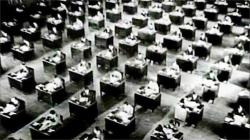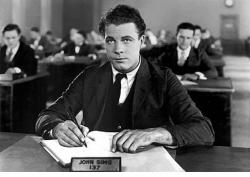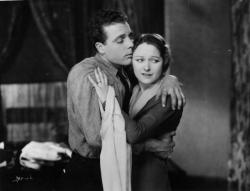Movie Review
The Crowd

US Release Date: 03-03-1928
Directed by: King Vidor
Starring▸▾
- James Murray, as
- John
- Eleanor Boardman, as
- Mary
- Bert Roach, as
- Bert
- Estelle Clark, as
- Jane
- Daniel G. Tomlinson, as
- Jim
- Dell Henderson, as
- Dick
- Lucy Beaumont, as
- Mary's Mother
- Freddie Burke Frederick, as
- Junior
- Alice Mildred Puter as
- Daughter
![4 star[s] out of 4](../static/images/global/featured_gold_stars.png)

The most famous shot in King Vidor's The Crowd.
The Crowd is another movie released at the very end of the silent era that shows just how advanced the art form of the movies had become before they all began talking. Released in 1928 and directed by King Vidor, it tells the uncompromising story of John and Mary, a young married couple who endure hard times and tragedy together.
This melodrama is most famous for a long tracking shot where the camera pans up the outside of a tall office building, then in a window to reveal a huge room filled with men working at identical desks set in long rows (see photo). The camera continues to pan into the room until it finds and closes in on one man in the crowd. This simple idea has been copied many times in other films over the decades.
John Sims was born on July 4, 1900. His father has big dreams for his son but he dies when Johnny is only 12. When he is 21 John goes off to the big city to become a success. As he arrives by boat, with the New York skyline before him, another passenger tells him, “You've gotta be good in that town if you want to beat the crowd.”
He gets a job working for a large insurance agency, goes on a blind double date with a coworker to Coney Island, and proposes to his date (Mary) at the end of the evening. They honeymoon in Niagara Falls, move into a cold water flat, and have a couple of children. Tragedy soon strikes and John and Mary's life together will never be the same.
King Vidor cast unknown actors to give the movie as authentic a feel as possible. He also shot scenes, surreptitiously, on the streets of New York City. The crowds in these scenes aren't hired extras but actual New Yorkers going about their day. In this regard the movie is an amazing time capsule of a vanished world. The theme of being just one tiny cog in a giant wheel is reinforced over and over again. The script includes some rather clever foreshadowing.
King Vidor's second wife Eleanor Boardman played Mary. She proves herself a fine dramatic actress. But it is James Murray as John Sims who really stands out. He was universally hailed for his incredibly touching performance. He is great throughout the film but is best in the scene where he contemplates suicide.
In real life James Murray was a tragic figure in early Hollywood history. He never again achieved the success of this role. By the early 30s he was drinking heavily and playing bit parts. He was eventually reduced to begging for spare change on the street and, according to Hollywood legend, one day tried panhandling a man that turned out to be King Vidor. In 1936 James Murray's body was pulled from the Hudson River. It was never ruled whether his death was an accident or suicide. Vidor was so deeply moved by his fate that he spent years writing a screenplay about Murray's life. It was never made into a movie however.
One bit of amusing trivia related to this very serious film is that it was the very first American movie to show a toilet on screen (although this isn't provable as so many silent movies have been lost over the years). According to Hollywood legend Louis B. Mayer hated this movie and in particular this scene. Irving Thalberg gave the script the green light, even though it didn't have a typical happy ending, because of Vidor's remarkable track record for MGM. Vidor filmed several different endings but he insisted that the more logical one be kept in the finished film.
The Crowd, as much of a cliche as it is to say this, is a true masterpiece of early cinema. It was one of the first 25 films to be selected for preservation in the United States National Film Registry by the Library of Congress in 1989.
![4 star[s] out of 4](../static/images/global/featured_gold_stars.png)

James Murray in The Crowd
Although The Crowd is practically a century old, it remains very true to life in its depiction of a man’s ordinary life. During the depression and World War II, Hollywood films centered on escapism for a weary public. It would not be until The Best Years of Our Lives (1946) that another film about ordinary people would garner such attention and award consideration. In the 1960s, French director Jean-Luc Godard was asked why more films were not made about ordinary people, and his response was "Why remake The Crowd? It has already been done".
The film begins with anticipation. When John is born, his father proudly states to the doctor, “There’s a little man the world is going to hear from alright, Doctor.” At twelve years of age, John and some other children speak about what they all want to be when they grow up. When on his first date with Mary, they see a man dressed as a clown, to which Mary remarks, “The poor sap! And I bet his father thought he would be President!”
The honeymoon scene on the train is the film's lightest moment with the expectation of sex. A couple of men tease John about what they know he is about to do as he washes up. They find a book in his bag titled, “What Young Husbands Ought to Know” and have a good laugh over it. When he gets to his sleeping car, a nervous Mary has turned her back to him. It Is not until the romantic kissing scene by Niagara falls that it is clear these two have been intimate.
Reality soon sets in. Their first apartment is tiny and next to train tracks. He does not care for her family any more than they care for him when they come for Christmas. He visits his friend’s place where he is reminded of what being single was like. John and Mary argue over things not working around the house. His hair starts to thin while he comments that she no longer keeps herself up. They become so frustrated with each other that they threaten to leave each other. They make up with the revelation that Mary is pregnant. Things seem to get better and they have a second child.
Then tragedy strikes in the form of a death in the family. What I found poetic about this scene is that it comes just after a windfall. I was reminded of In America (2003) and its brilliant depiction of a family’s ups and downs. I have found that life is not a steady incline or decline. Life has highs and lows and sometimes they come right after each other, as so perfectly depicted here. The only problem I had with The Crowd was that there are far too many low points in this man’s life and not enough high. Sure, life has its struggles but this film became a bit depressing.
I was truly hoping for a happy Hollywood ending no matter how unrealistic it may be. It is very easy for any man of a certain age to relate to John. His problems are universal. There is truly nothing unique about John, making him an extraordinary movie character. The ending is not what I had hoped for but it stays with the tone. The brilliance of this film is that the subject matter is as sincere as life itself.
Patrick mentioned the skyscraper scene while I was struck by another one. I liked when John walked into the recovery ward filled with women recovering from child birth. Of course this is a huge moment for John and Mary but King Vidor’s direction shows us that they are just one of many couples in a crowd. The recovery room is needlessly large, emphasizing just how small and unexceptional their lives are in the big scheme of society.
I agree Patrick, The Crowd is a masterpiece.

James Murray and Eleanor Boardman in The Crowd.
I concur with my brothers that this film is a masterpiece. Seen from the perspective of today, it's easy to forget how innovative the filming techniques were, but as Patrick said, with the advent of sound, it would be many years before camera movements as fluid as those used here would be possible again.
Patrick and Eric both mentioned specific scenes that showcase John as a member of the crowd (hence the title), but those are hardly the only ones. Nearly every scene is setup to emphasize that he is just one of many. A cog in a giant wheel, as Patrick put it. The bathroom with its long line of sinks. The stream of women coming out of the revolving door only to be paired up with a generic man. The people on the bus, the subway and the streets. All of these scenes demonstrate how un-unique John is.
Although this is famously the story of an "ordinary" man, is it really? As Eric pointed out, many aspects of life from a century ago remain true today, but this is a very cynical, depressing view of "ordinary" life. John's life is a gradual, but continual journey downwards. His life is glum and ultimately tragic. Is this how Vidor saw the life of the masses? Grey, depressing and sad with just a few moments of joy snatched here and there to break up the monotony?
As Patrick wrote, the ending of the film is so downbeat that Thalberg and the studio insisted that a couple of different happier endings be shot. Vidor stood by his vision though and the bleaker one made it into the film. Thalberg was so unsure of the film that he held it back from release for a year, which probably hurt its box office. As innovative as it was, by the time it was released, silent films were on their way out. It would take a few years before it would be acknowledged as the work of art that it is.
This is the sort of film that any serious fan of cinema and its history should watch at least once. However, because of the bleak nature of its story, once might be enough.
Photos © Copyright Metro-Goldwyn-Mayer (MGM) (1928)


